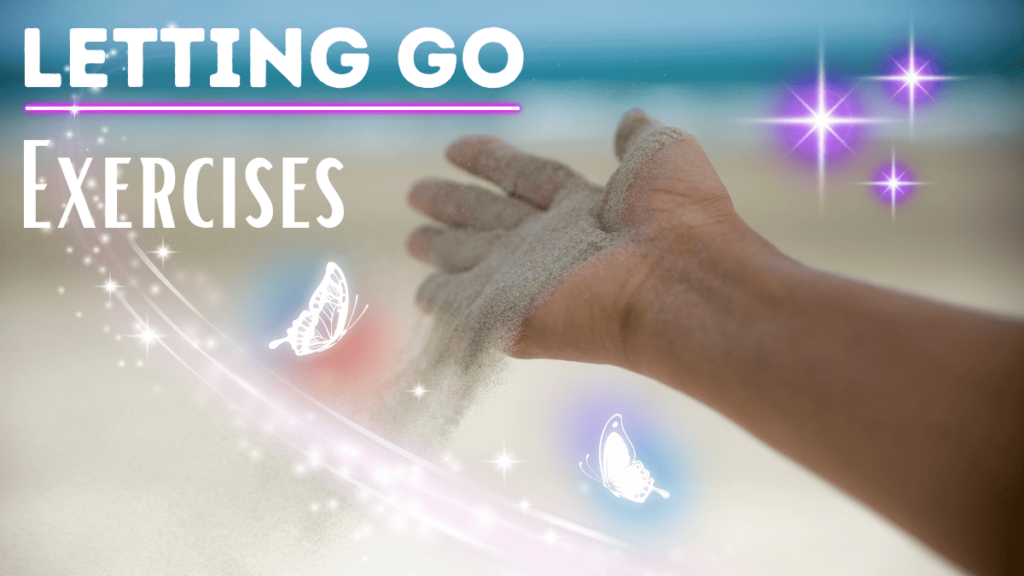Feeling weighed down by regrets, grudges, and frustrations? Not enough space in your mind for positivity when overflowing worries occupy your thoughts?
Imagine being able to consciously set all that baggage down, freeing your mental energy for the present moment. Letting go can do just that – but like any skill, it takes practice.
This article shares 5 easy daily letting go practices intended to help increase your inner calm, emotional balance, and ability to embrace joy.
Once you try this daily ritual, you’ll reclaim mental bandwidth you never realized you’d lost. So take a deep breath and get ready to let go of what no longer serves you!
Remember that you don’t need to do all these exercises every day. Pick the ones that you like the most and stick to them for some time to see the results.
With consistency, you’ll intuitively unload mental clutter and reclaim freedom to fully show up for each new day.

1. Breathing Exercises
Many retain stress in their bodies without realizing it, leading to shallow breathing patterns. Deep intentional breathing is like hitting a mental reset button – it calms nerves, lowers heart rate, and alleviates tension.
Set aside 5 minutes daily to focus solely on your breath. Sit comfortably with eyes closed. Place one hand on your abdomen and inhale slowly through your nose, allowing your belly to expand with air.
Complete the inhale then pause briefly before exhaling fully out through your mouth. Iterate several rounds, focusing on the sensation and rhythm of your breath.
As thoughts bubble up, acknowledge then release them, continually returning attention to your breathing anchor.
Visualize tension and rigidity in both mind and body dissipating with each exhale. End by taking a refreshing breath in through your nose and out through your mouth.
Centering yourself with breathwork clears out frenzied mental clutter, making space to let go of rumination.
It allows you to be fully present rather than swirling in unhelpful thoughts of past or future.
Use it first thing in the morning to set the tone for release, or as an anytime ritual when you notice negative thought patterns taking over.
2. Journaling
Journaling allows you to dump all your thoughts, worries, and emotions onto paper. The act of expressing them in writing is cathartic and helps process inner experiences rather than letting them accumulate and spin in your mind.
Keep a notebook dedicated just for daily journaling. Each morning, date a new entry then set a 5 minute timer.
Freewrite without self-judgement everything flowing through your mind – anxieties, frustrations, upsets, hurts. Allow your pen to purge it all out onto the pages.
When the timer dings, read back what you wrote. Notice the release you feel having expressed it. Then close the journal, leaving those thoughts trapped on the pages.
The insights within can be revisited if needed, but the emotional intensity is now separated from you. Your mind is freed up, uncluttered by the excessive rerun of mental tapes.
Consistently journaling trains your brain over time to let go as an intuitive reflex when emotional overwhelm strikes.
Use a journal to regularly clear out mental clutter and reclaim focus for each new day.

Here is an example journal entry for letting go:
April 5th
I can't stop replaying my argument with mom over and over. Why does she always have to criticize everything I do? She only focuses on what's wrong instead of giving encouragement. I try so hard but it's never good enough. Her words sting and put me in a bad mood all day.
I ended up snapping at my friend when she asked me for notes later in class. I felt bad but was still stewing about mom. The tense talk keeps looping in my mind on repeat even though I want to let it go. My chest feels tight and I just don't have mental space for positivity right now.
Why can't mom be nurturing for once? I'm tired of her judgement about my grades, my appearance, my interests. The constant picking apart hurts. I wish she would just accept me as I am. I know holding onto frustration doesn't help but I don't know how to break this cycle. I have to find some way to let this go so I can relax. For now I can at least get the circular thoughts out here.
This example covers venting the emotional intensity in the moment with some reflection. The act of journaling itself then allows release and fresh mental space after closing the notebook.
3. Visualization
Our imagination is a powerful tool for manifesting emotional release. Through guided mental imagery, you can envision literally setting down symbolic burdens as a representation of letting go.
Find a quiet space and close your eyes. Picture yourself surrounded by stunning natural scenery like mountains, beach, forest, or meadow. In your hands you hold a heavy object containing all your built-up mental baggage – regrets, grudges, obsessive thoughts, worries. Feel the weight of it and how your muscles strain under the load.
Now see yourself arriving at outlook point, a serene cliff edge overlooking the sprawling scene below. Kneel down and with great intention, slowly lower the heavy object off the cliff, trusting it to gravity’s pull. Watch it fall farther and farther down until disappearing into the distance. Feel your body become lighter and more relaxed without bearing that weight. Take an effortless breath of fresh air.
End the visualization by opening your eyes and stretching comfortably. Use this symbolic imagery of unburdening daily to reinforce emotional release from draining thoughts. Replace rumination loops with scenes of setting down stressors and breathe freely.

4. Meditation
Meditation builds the mindfulness skill of acknowledging distressing thoughts then watching them fade without judgement. Practiced regularly, it strengthens your mental capacity to let go.
Find a quiet space to sit comfortably for 5-10 minutes. Close your eyes and turn focus to your breathing, feeling each natural inhale and exhale. When thoughts, worries, or distractions intervene, don’t resist them. Note their presence then gently return attention back to your breath.
Imagine thoughts as clouds slowly drifting by in the sky while your breathing remains constant as the ground below. Or picture worries as leaves floating along the surface of a stream while your breath is the stable stream bed underneath. Use these visual metaphors if they help distance yourself from unproductive rumination loops.
As the meditation concludes, feel a sense of letting go occur naturally without effort. Continue incorporating short meditations frequently to give practice releasing thoughts with acceptance rather than frustration.
In time, letting go will become second nature, trained through patient consistency.
Your mind will find rest, not unrest, when you pause to reset attention fully on the present through your breath.
5. Gratitude Journal
When focused on lack, the mind stays locked in thoughts of stress or bitterness. Shifting the frame to express gratitude unshackles your thoughts from what doesn’t measure up.
Each morning upon waking, grab a notebook or open a digital doc, set a timer for 5 minutes and create your gratitude list. Write down 3-5 specific things you feel genuinely thankful for today – a refreshing shower, tasty breakfast, cozy bed, reassuring text from a loved one.
Reflect on how each item improved your life in that moment.
List different blessings daily rather than repeating. Even on tough days, shine a light on some detail like a favorite song on the radio or the sound of raindrops to cultivate thankfulness.
This trains your brain to spot moments of grace that displace the worries.
Gratitude fills you up from the inside, overflowing your cup so there’s no room left for resentment or bitterness to take hold.
As you commit to the consistent practice of starting your days giving thanks, you’ll find anxiety and stress dissipate more quickly since less mental space is available to host them.
Use gratitude journaling whenever you need a reset into the mindset of letting be.

Two extra exercises:
6. Body Scanning
Our bodies often subconsciously harbor tension tied to emotional baggage over time. Doing a full body scan helps bring awareness to areas clenching stress, allowing you to deliberately relax.
Find a comfortable place to lie down, closing your eyes. Take a full, deep breath, slowly scanning your attention from the top of your head down through each body part – forehead, eyes, jaws, neck shoulders, arms, chest, back, abdomen, hips, legs, feet. Notice areas holding tightness.
Visualize the act of softening any tension detected as you continue moving down the body. Imagine rigidity dissipating as you consciously relax each muscle group before moving attention to the next. After completing the head-to-toe scan, enjoy the sensation of your fully relaxed being.
Releasing physical tightness serves as a cue to let go of pent-up emotions tied to that tension as well.
Perform body scans frequently to help reinforce mind-body harmony through consciously shedding accumulated stress.
Here’s an example body scan experience:
*noticing forehead tension as scan begins, picturing smooth relaxation entering as I consciously soften crunched muscles
*feeling aches drain from neck with exhalations as I invite shoulders to sink down, unburdened
*warm comfort swaddling my abdomen, hips, quadriceps as I welcome softness into areas where I carry rigid stress
*tingles of renewal spreading down to feet as I progressively turn my focus to loosening each body part

7. List Burning
Syntax and symbolic catharsis combine in this expressive letting go exercise. Writing down grievances grants them weight and form. The act of burning that list removes their power and presence.
On a sheet of paper make a numbered list of grudges, regrets, frustrations, disappointments you are finally ready to release your attachment to by choice.
Be as specific or vague as feels right – a person’s name, an event, emotions like anger or betrayal. Reflect on each item briefly before moving to the next.
When complete with all that currently comes to mind, go outside safely and burn the corner of the paper, letting it fully turn to ash in a fireproof dish or grassy patch of yard.
As you watch the flames consume your list into smoldering ember, tell yourself “I consciously let this go” with each number that disappears.
The visibility of literally seeing what you are releasing makes the commitment real, providing emotional closure.
Let the remains blow away in wind or water for a symbolic fresh start. Revisit this exercise any time additional burdens surface that you decide are ready for relinquishment.
This allows you to tangibly witness old pains burning up and dissipating as you free yourself from carrying them forward into your present and future.
Final Thoughts
Releasing emotional baggage from our minds is an ongoing process rather than an accomplished state. But a daily letting go ritual trains our brain toward clarity and expansiveness through dedicated practice.
Just 5 minutes focused intentionally on breathwork, journaling, visualization, meditation or gratitude can center us for release instead of rumination when faced with inevitable daily stresses.
Choose one exercise as feels right each day or rotate through them. Over time you’ll intuitively let go quicker with less inner turbulence.
Leaving worries on the page or picturing them drift away makes room mentally and emotionally to fully inhabit the gift of now with more wonder and ease.
Your cup can only truly overflow with optimism and inspiration the emptier it is of obtrusive, draining clutter from the past.
So do yourself the favor of setting aside just 300 seconds to unburden.
The effects will ripple out providing a refuge of mindfulness to handle all that arises with wisdom, discernment and grace.

You may also be interested in: 1. Short & Valuable Life Lessons 2. Remember to Live. Your Time is Limited.




